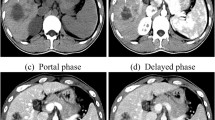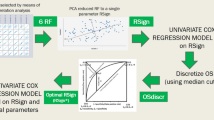Abstract
Objectives
To determine whether washout characteristics of dynamic contrast-enhanced computed tomography (CT) could predict survival in patients with extrahepatic cholangiocarcinoma (EHC).
Methods
This study collected 46 resected cases. All cases were examined by dynamic contrast study on multidetector-row CT. Region-of-interest measurements were obtained at the non-enhanced, portal venous phase and delayed phase in the tumour and were used to calculate the washout ratio as follows: [(attenuation value at portal venous phase CT − attenuation value at delayed enhanced CT)/(attenuation value at portal venous phase CT − attenuation value at unenhanced CT)] × 100. On the basis of the median washout ratio, we classified the cases into two groups, a high-washout group and low-washout group. Associations between overall survival and various factors including washout rates were analysed.
Results
The median washout ratio was 29.4 %. Univariate analysis revealed that a lower washout ratio, venous invasion, lymphatic permeation and lymph node metastasis were associated with shorter survival. Multivariate analysis identified the lower washout ratio as an independent prognostic factor (hazard ratio, 3.768; p value, 0.027).
Conclusions
The washout ratio obtained from the contrast-enhanced CT may be a useful imaging biomarker for the prediction of survival of patients with EHC.
Key points
• Dynamic contrast study can evaluate the aggressiveness of extrahepatic cholangiocarcinoma.
• A lower washout ratio was an independent prognostic factor for overall survival.
• CT can predict survival and inform decisions on surgical options or chemotherapy.




Similar content being viewed by others
Abbreviations
- DPA:
-
attenuation on delayed phase contrast-enhanced scans
- EHC:
-
extrahepatic cholangiocarcinoma
- ICC:
-
intrahepatic cholangiocarcinoma
- PA:
-
precontrast attenuation
- PVPA:
-
attenuation on portal venous scans
- WR:
-
washout ratio
References
Khan SA, Taylor-Robinson SD, Toledano MB, Beck A, Elliott P, Thomas HC (2002) Changing international trends in mortality rates for liver, biliary and pancreatic tumours. J Hepatol 37:806–813
Sobin LH, Gospodarowicz M, Wittekind C (2009) TNM classification of malignant tumors, 7th edn. Wiley, Chichester
Wakai T, Shirai Y, Moroda T, Yokoyama N, Hatakeyama K (2005) Impact of ductal resection margin status on long-term survival in patients undergoing resection for extrahepatic cholangiocarcinoma. Cancer 103:1210–1216
Murakami Y, Uemura K, Hayashidani Y, Sudo T, Ohge H, Sueda T (2007) Pancreatoduodenectomy for distal cholangiocarcinoma: prognostic impact of lymph node metastasis. World J Surg 31:337–342.
Murakami Y, Uemura K, Sudo T et al (2013) Perineural invasion in extrahepatic cholangiocarcinoma: prognostic impact and treatment strategies. J Gastrointest Surg 17:1429–1439
Cho MS, Kim SH, Park SW et al (2012) Surgical outcomes and predicting factors of curative resection in patients with hilar cholangiocarcinoma: 10-year single-institution experience. J Gastrointest Surg 16:1672–1679
Cai WK, Lin JJ, He GH, Wang H, Lu JH, Yang GS (2014) Preoperative serum CA19-9 levels is an independent prognostic factor in patients with resected hilar cholangiocarcinoma. Int J Clin Exp Pathol 7:7890–7898
Zhou Y, Liu S, Wu L, Wan T (2015) Survival after surgical resection of distal cholangiocarcinoma: a systematic review and meta-analysis of prognostic factors. Asian J Surg. doi:10.1016/j.asjsur.2015.07.002
Kim SA, Lee JM, Lee KB et al (2011) Intrahepatic mass-forming cholangiocarcinomas: enhancement patterns at multiphasic CT, with special emphasis on arterial enhancement pattern–correlation with clinicopathologic findings. Radiology 260:148–157
Asayama Y, Yoshimitsu K, Irie H et al (2006) Delayed-phase dynamic CT enhancement as a prognostic factor for mass-forming intrahepatic cholangiocarcinoma. Radiology 238:150–155
Nakanuma Y, Sato Y (2014) Hilar cholangiocarcinoma is pathologically similar to pancreatic duct adenocarcinoma: suggestions of similar background and development. J Hepatobiliary Pancreat Sci 21:441–447
Ercolani G, Dazzi A, Giovinazzo F et al (2015) Intrahepatic, peri-hilar and distal cholangiocarcinoma: three different locations of the same tumor or three different tumors? Eur J Surg Oncol 41:1162–1169
Kim JE, Lee JM, Kim SH et al (2010) Differentiation of intraductal growing-type cholangiocarcinomas from nodular-type cholangiocarcinomas at biliary MR imaging with MR cholangiography. Radiology 257:364–372
Miyazaki M, Ohtsuka M, Miyakawa S et al (2015) Classification of biliary tract cancers established by the Japanese Society of Hepato-Biliary-Pancreatic Surgery: 3(rd) English edition. J Hepatobiliary Pancreat Sci 22:181–196
Kajiyama K, Maeda T, Takenaka K, Sugimachi K, Tsuneyoshi M (1999) The significance of stromal desmoplasia in intrahepatic cholangiocarcinoma: a special reference of 'scirrhous-type' and 'nonscirrhous-type' growth. Am J Surg Pathol 23:892–902
Aishima S, Oda Y (2015) Pathogenesis and classification of intrahepatic cholangiocarcinoma: different characters of perihilar large duct type versus peripheral small duct type. J Hepatobiliary Pancreat Sci 22:94–100
Jarnagin WR, Bowne W, Klimstra DS et al (2005) Papillary phenotype confers improved survival after resection of hilar cholangiocarcinoma. Ann Surg 241:703–712.
Choi YH, Lee JM, Lee JY et al (2008) Biliary malignancy: value of arterial, pancreatic, and hepatic phase imaging with multidetector-row computed tomography. J Comput Assist Tomogr 32:362–368
Lacomis JM, Baron RL, Oliver JH 3rd, Nalesnik MA, Federle MP (1997) Cholangiocarcinoma: delayed CT contrast enhancement patterns. Radiology 203:98–104
Itai Y, Ohtomo K, Kokubo T et al (1986) CT of hepatic masses: significance of prolonged and delayed enhancement. AJR Am J Roentgenol 146:729–733
Kim NR, Lee JM, Kim SH et al (2008) Enhancement characteristics of cholangiocarcinomas on mutiphasic helical CT: emphasis on morphologic subtypes. Clin Imaging 32:114–120
Nishie A, Asayama Y, Ishigami K et al (2014) Pathological manifestation of difference in washout pattern of adrenal hyperplasia on dynamic CT. J Med Imaging Radiat Oncol 58:559–564
Boland GW (2011) Adrenal imaging: why, when, what, and how? Part 2. What technique? AJR Am J Roentgenol 196:W1–W5
Acknowledgments
The scientific guarantor of this publication is Professor Hiroshi Honda. The authors of this manuscript declare no relationships with any companies whose products or services may be related to the subject matter of the article. This work was supported by the Japan Society for the Promotion of Science (JSPS) KAKENHI Grant Number 16 K10282. No complex statistical methods were necessary for this paper. Institutional review board approval was obtained. Written informed consent was waived by the institutional review board. Study subjects or cohorts have not been previously reported.
Methodology: retrospective, diagnostic or prognostic study/observational, performed at one institution.
Author information
Authors and Affiliations
Corresponding author
Rights and permissions
About this article
Cite this article
Asayama, Y., Nishie, A., Ishigami, K. et al. Prognostic significance of contrast-enhanced CT attenuation value in extrahepatic cholangiocarcinoma. Eur Radiol 27, 2563–2569 (2017). https://doi.org/10.1007/s00330-016-4621-y
Received:
Revised:
Accepted:
Published:
Issue Date:
DOI: https://doi.org/10.1007/s00330-016-4621-y




